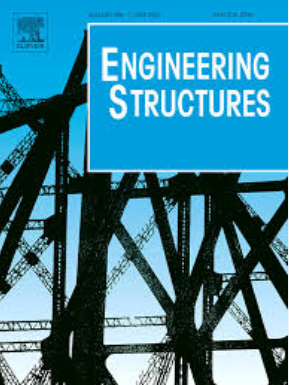Damage-informed seismic fragility of non-structural elements in South Iceland: A Bayesian hierarchical approach
IF 5.6
1区 工程技术
Q1 ENGINEERING, CIVIL
引用次数: 0
Abstract
This study assesses the seismic fragility of residential buildings in Iceland, examining both structural and non-structural damage resulting from the earthquakes of 2000 and 2008. Leveraging detailed loss datasets from these events, we apply a Bayesian Hierarchical Fragility Framework with a separate Bernoulli approach to derive empirical fragility functions for multiple damage states. This method integrates a spatially correlated latent intensity measure field inferred from ground-motion prediction equations (GMPEs), explicitly capturing both the spatial correlation and inherent uncertainty of GMPEs using Markov-Chain Monte Carlo (MCMC) sampling. By simultaneously modeling all damage states within a unified framework, while assigning distinct fragility parameters to each state, this approach leverages damage observations from all states to infer the latent IM field. This joint inference captures both the variability in the experienced IM at each building and the uncertainty in how that IM translates into observed damage responses. This research marks the first effort to specifically quantify the seismic fragility of non-structural damage in Icelandic buildings. Non-structural elements, which represent a significant proportion of total construction costs, contribute extensively to losses in global seismic events, often occurring even at low levels of ground shaking. The results underscore that non-structural components like interior fixtures and flooring are particularly vulnerable, more so than structural elements. Despite improvements in seismic codes, this study reveals a persistent vulnerability, underscoring the urgent need for targeted design and construction strategies that enhance the resilience of non-structural elements to ensure better overall building seismic functionality.
南冰岛非结构构件的地震易损性:贝叶斯分层方法
本研究评估了冰岛住宅建筑的地震脆弱性,检查了2000年和2008年地震造成的结构和非结构破坏。利用这些事件的详细损失数据集,我们应用贝叶斯分层脆弱性框架和单独的伯努利方法来推导多种损伤状态的经验脆弱性函数。该方法集成了从地震动预测方程(GMPEs)推断出的空间相关潜在强度测量场,利用马尔可夫链蒙特卡罗(MCMC)采样明确捕获了GMPEs的空间相关性和固有不确定性。通过在统一框架内同时建模所有损伤状态,同时为每个状态分配不同的脆弱性参数,该方法利用所有状态的损伤观察来推断潜在的IM场。这种联合推理既抓住了每座建筑中经验到的即时情况的可变性,也抓住了即时情况如何转化为观察到的损害反应的不确定性。这项研究标志着第一次具体量化冰岛建筑物非结构破坏的地震脆弱性的努力。非结构因素占总建筑成本的很大一部分,在全球地震事件中造成了很大的损失,即使在低水平的地面震动中也经常发生。研究结果强调,室内固定装置和地板等非结构部件比结构部件更容易受到伤害。尽管抗震规范有所改进,但这项研究揭示了一个持续存在的脆弱性,强调迫切需要有针对性的设计和施工策略,提高非结构构件的弹性,以确保更好的整体建筑抗震功能。
本文章由计算机程序翻译,如有差异,请以英文原文为准。
求助全文
约1分钟内获得全文
求助全文
来源期刊

Engineering Structures
工程技术-工程:土木
CiteScore
10.20
自引率
14.50%
发文量
1385
审稿时长
67 days
期刊介绍:
Engineering Structures provides a forum for a broad blend of scientific and technical papers to reflect the evolving needs of the structural engineering and structural mechanics communities. Particularly welcome are contributions dealing with applications of structural engineering and mechanics principles in all areas of technology. The journal aspires to a broad and integrated coverage of the effects of dynamic loadings and of the modelling techniques whereby the structural response to these loadings may be computed.
The scope of Engineering Structures encompasses, but is not restricted to, the following areas: infrastructure engineering; earthquake engineering; structure-fluid-soil interaction; wind engineering; fire engineering; blast engineering; structural reliability/stability; life assessment/integrity; structural health monitoring; multi-hazard engineering; structural dynamics; optimization; expert systems; experimental modelling; performance-based design; multiscale analysis; value engineering.
Topics of interest include: tall buildings; innovative structures; environmentally responsive structures; bridges; stadiums; commercial and public buildings; transmission towers; television and telecommunication masts; foldable structures; cooling towers; plates and shells; suspension structures; protective structures; smart structures; nuclear reactors; dams; pressure vessels; pipelines; tunnels.
Engineering Structures also publishes review articles, short communications and discussions, book reviews, and a diary on international events related to any aspect of structural engineering.
 求助内容:
求助内容: 应助结果提醒方式:
应助结果提醒方式:


